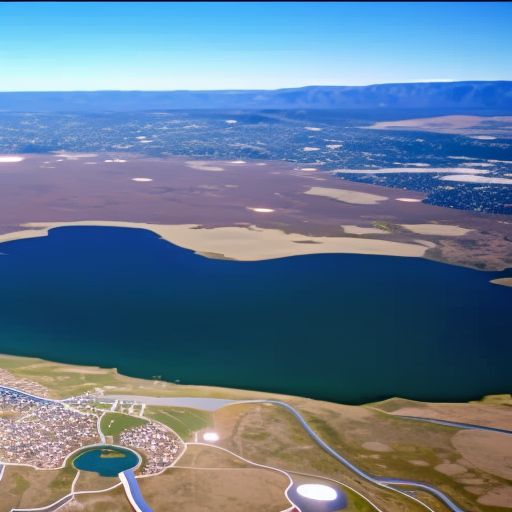Environmental groups petition EPA to reconsider Colorado’s ozone management plan
Environmental groups petition EPA to reconsider Colorado's ozone management plan The Denver Gazette


Lawsuit Challenges Colorado’s Plan to Reduce Ozone Pollution
Environmental organizations 350 Colorado and the Center for Biological Diversity have filed a federal lawsuit challenging the Environmental Protection Agency’s (EPA) approval of Colorado’s plan to reduce ozone pollution along the northern Front Range.
Insufficient Measures to Address Pollution from Fracked Oil and Methane Gas
The organizations argue that Colorado’s plan does not go far enough in addressing pollution from fracked oil and methane gas. They claim that the plan’s approval by the EPA, despite its previous failure, allows the oil and gas industry to continue emitting pollutants that contribute to asthma attacks and other health issues.
The Impact of Ozone Pollution on Sustainable Development Goals
Ozone pollution poses a significant threat to the achievement of several Sustainable Development Goals (SDGs). The SDGs aim to address global challenges, including environmental sustainability. By reducing ozone pollution, Colorado can contribute to SDG 3 (Good Health and Well-being) by improving air quality and reducing the health risks associated with pollution.
Background on Colorado’s Ozone Pollution Reduction Plan
The state’s air plan has been in development since before Governor Jared Polis took office in 2019. The northern Front Range region, consisting of eight counties, has been struggling with seasonal ozone problems for decades. In 1978, the region was designated as a “nonattainment” area when ozone levels exceeded the national ambient air quality standard set by the EPA.
In 2018, the EPA reclassified the region as “serious” non-attainment, triggering revisions to the state implementation plan (SIP). The SIP outlines how Colorado will meet the ozone standards by 2027. However, in April, the EPA downgraded the region to “severe” non-attainment, requiring the use of reformulated gasoline starting in 2024.
Importance of Addressing Out-of-State Sources of Ozone Pollution
Data from the Regional Air Quality Council shows that a significant portion of ozone pollution in the region is attributable to out-of-state sources. Between 36 and 39 parts per billion of ozone levels exceeding the federal limit of 75 parts per billion can be attributed to these sources. This highlights the need for collaborative efforts beyond state boundaries to effectively address ozone pollution.
The Role of Oil and Gas in Ozone Pollution
The oil and gas industry has been identified as a contributor to ozone pollution in the non-attainment area. However, CEO of the Colorado Oil and Gas Association, Dan Haley, disputes the claim that the industry is solely responsible for exceeding ozone standards. He emphasizes that oil and gas operations account for only a small percentage of ozone levels, with natural sources contributing the majority.
Implications of the Lawsuit
If the court finds that either the EPA or the state improperly approved the SIP, it could result in more stringent limits on oil and gas operations. Additionally, there may be a need to lower the amount of ozone-forming pollutants emitted by cars and trucks in the Denver Metro/North Front Range area.
Conclusion
The lawsuit filed by 350 Colorado and the Center for Biological Diversity challenges Colorado’s plan to reduce ozone pollution along the northern Front Range. The outcome of this lawsuit could have significant implications for addressing ozone pollution and achieving the Sustainable Development Goals related to environmental sustainability and public health.
SDGs, Targets, and Indicators
1. Which SDGs are addressed or connected to the issues highlighted in the article?
- SDG 3: Good Health and Well-being
- SDG 7: Affordable and Clean Energy
- SDG 11: Sustainable Cities and Communities
- SDG 13: Climate Action
- SDG 15: Life on Land
2. What specific targets under those SDGs can be identified based on the article’s content?
- SDG 3.9: By 2030, substantially reduce the number of deaths and illnesses from hazardous chemicals and air, water, and soil pollution and contamination.
- SDG 7.2: By 2030, increase substantially the share of renewable energy in the global energy mix.
- SDG 11.6: By 2030, reduce the adverse per capita environmental impact of cities, including by paying special attention to air quality and municipal and other waste management.
- SDG 13.1: Strengthen resilience and adaptive capacity to climate-related hazards and natural disasters in all countries.
- SDG 15.1: By 2020, ensure the conservation, restoration, and sustainable use of terrestrial and inland freshwater ecosystems and their services.
3. Are there any indicators mentioned or implied in the article that can be used to measure progress towards the identified targets?
- Number of deaths and illnesses related to air pollution
- Share of renewable energy in the energy mix
- Adverse per capita environmental impact of cities, including air quality
- Resilience and adaptive capacity to climate-related hazards
- Conservation, restoration, and sustainable use of terrestrial ecosystems
Table: SDGs, Targets, and Indicators
| SDGs | Targets | Indicators |
|---|---|---|
| SDG 3: Good Health and Well-being | Target 3.9: By 2030, substantially reduce the number of deaths and illnesses from hazardous chemicals and air, water, and soil pollution and contamination. | Number of deaths and illnesses related to air pollution |
| SDG 7: Affordable and Clean Energy | Target 7.2: By 2030, increase substantially the share of renewable energy in the global energy mix. | Share of renewable energy in the energy mix |
| SDG 11: Sustainable Cities and Communities | Target 11.6: By 2030, reduce the adverse per capita environmental impact of cities, including by paying special attention to air quality and municipal and other waste management. | Adverse per capita environmental impact of cities, including air quality |
| SDG 13: Climate Action | Target 13.1: Strengthen resilience and adaptive capacity to climate-related hazards and natural disasters in all countries. | Resilience and adaptive capacity to climate-related hazards |
| SDG 15: Life on Land | Target 15.1: By 2020, ensure the conservation, restoration, and sustainable use of terrestrial and inland freshwater ecosystems and their services. | Conservation, restoration, and sustainable use of terrestrial ecosystems |
Behold! This splendid article springs forth from the wellspring of knowledge, shaped by a wondrous proprietary AI technology that delved into a vast ocean of data, illuminating the path towards the Sustainable Development Goals. Remember that all rights are reserved by SDG Investors LLC, empowering us to champion progress together.
Source: denvergazette.com

Join us, as fellow seekers of change, on a transformative journey at https://sdgtalks.ai/welcome, where you can become a member and actively contribute to shaping a brighter future.







